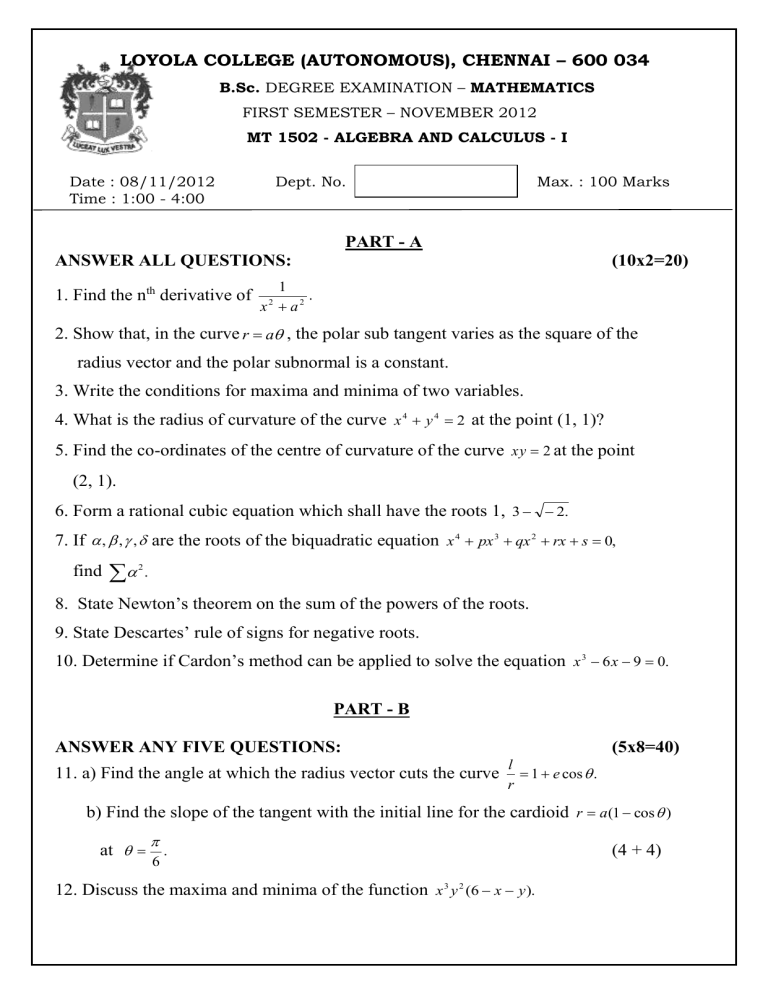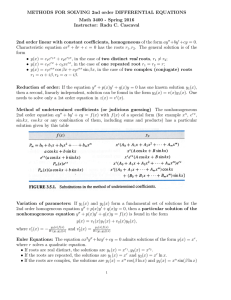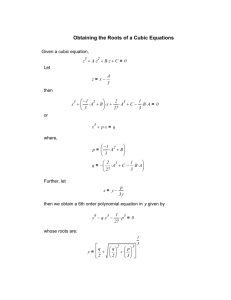Document 15510829

LOYOLA COLLEGE (AUTONOMOUS), CHENNAI – 600 034
B.Sc. DEGREE EXAMINATION – MATHEMATICS
FIRST SEMESTER – NOVEMBER 2012
Date : 08/11/2012
Time : 1:00 - 4:00
MT 1502 - ALGEBRA AND CALCULUS - I
Dept. No. Max. : 100 Marks
ANSWER ALL QUESTIONS:
1. Find the n th derivative of
1 x
2 a
2
.
PART - A
(10x2=20)
2. Show that, in the curve r
a
, the polar sub tangent varies as the square of the
radius vector and the polar subnormal is a constant.
3. Write the conditions for maxima and minima of two variables.
4. What is the radius of curvature of the curve x
4 y
4
2 at the point (1, 1)?
5. Find the co-ordinates of the centre of curvature of the curve xy
2 at the point
(2, 1).
6. Form a rational cubic equation which shall have the roots 1, 3
2 .
7. If
,
,
,
are the roots of the biquadratic equation x
4 px
3 qx
2 rx
s
0 ,
find
2
.
8. State Newton’s theorem on the sum of the powers of the roots.
9. State Descartes’ rule of signs for negative roots.
10. Determine if Cardon’s method can be applied to solve the equation x
3
6 x
9
0 .
PART - B
ANSWER ANY FIVE QUESTIONS:
11. a) Find the angle at which the radius vector cuts the curve r l
1
e cos
.
(5x8=40)
b) Find the slope of the tangent with the initial line for the cardioid r
a ( 1
cos
)
at
6
.
(4 + 4)
12. Discuss the maxima and minima of the function x
3 y
2
( 6
x
y ).
13. Prove that the (p-r) equation of the cardioid r
a ( 1
cos
) is p
2 r
3
2 a
and hence
2
prove that its radius of curvature is
3
2 ar .
14. Show that the evolute of the cycloid x
a (
sin
) ; y
a ( 1
cos
) is another
cycloid.
15. Solve the equation 6 x
5 x
4
43 x
3
43 x
2 x
6
0 .
16. Show that the sum of the eleventh powers of the roots of x
7
5 x
4
1
0 is zero.
17. a) If
,
,
are the roots of the equation x
3 px
2 qx
r
0 , find the value of
(
2
1 )(
2
1 )(
2
1 ).
b) Determine completely the nature of the roots of the equation x
5
6 x
2
4 x
5
0 .
(5 + 3)
18. If
be a real root of the cubic equation x
3 px
2 qx
r
0 , of which the coefficients
are real, show that the other two roots of the equation are real, if p
2
4 q
2 p
3
2
.
PART - C
ANSWER ANY TWO QUESTIONS:
19. a) Find the n th differential coefficient of
b) If y
sin( m sin
1 x ) , prove that ( 1
x
2 cos
5
) y n
2
.
sin
7
( 2 n
.
1 ) xy n
1
( m
2 n
2
) y n
(2 x 20 = 40)
0 .
(10 +10)
20. A tent having the form of a cylinder surmounted by a cone is to contain a given
volume. If the canvass required is minimum, show that the altitude of the cone is
twice that of the cylinder.
21. a) Find the asymptotes of x
3
2 x
2 y
4 xy
2
8 y
3
4 x
8 y
1 .
b) Show that the roots of the equation x
3 px
2 qx
r
0 are in Arithmetical
progression if 2 p
3
equation x
3
6 x
2
9 pq
27 r
13 x
10
0
0 .
Show that the above condition is satisfied by the and hence solve it. (10 + 10)
22. Determine the root of the equation x
3
3 x
1
0 which lies between 1 and 2
correct to three places of decimals by Horner’s method.
$$$$$$$




